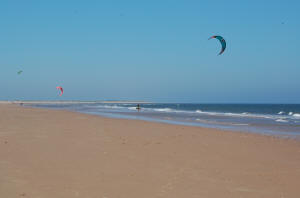Brancaster
|
| Brancaster lies on the North Norfolk coast between Titchwell and Burnham Deepdale.
It possesses a spectacular beach - with long, relatively
unspoilt stretches of sand and dunes. In recent years,
it has become a popular location for
kite-surfers.

Brancaster Beach
The beach features in Angela Huth's novel
Invitation
to the Married Life (1999). Huth, who was born in
1938, was a regular
visitor to Brancaster as a child - as her
parents had a holiday home in the village. She has
always found inspiration and tranquillity in the county
and values what she describes as the reassuring 'continuity' of Norfolk life.
The wreck featured in the passage is that of the
SS Vina. Originally it was part of the merchant navy -
but was towed up to Norfolk by the RAF to use as target
practice during WW2. It eventually sank in 1944. Today
it can only be seen at low tide.
|
| 'That Sunday
afternoon Mary and Bill and their dog Trust walked on
Brancaster beach. It was fine, but cool. They wore
gumboots and thick jumpers against an edgy breeze. Mary
had tied a scarf over her head so that only a fringe of
grey hair was free to skitter about her forehead. They
had been coming to the beach for years, in all weathers.
High summer was the only time they avoided. Then, crowds
- people had discovered the empty stretches of dune and
sand in the last decade - penetrated further and further
along. Although by normal seaside standards the place
was still thinly populated, they liked it best when it
appeared as they had first known it, long ago, empty but
for a lone distant figure looking for mussels, watching
the birds or walking a dog.
Over the years they had observed the gradual
disintegration of the wreck. Once a sturdy shell of a
ship blown up in the last War, it had slowly succumbed
to barnacles, seaweed, lashing storms and strong
currents. Now, when the tide was out, just a few posts
of blackened steel remained - to few to indicate the
former shape of the ship's bones. At high tide the two
or three posts protruding from the water could be missed
by all those unfamiliar with the disappearing kingdom.
There was a high tide this afternoon: sea dull as an
elephant's shank in moments when the cloud obscured the
sun. Then, when the sun passed, herbaceous blues and
greys and greens of a sophisticated garden border.
Mary loved the beach, its ankle-high gusts of sand
stinging here boots, its ribbed distances scrunchy with
shells, its wind-wrinkled pools blinking fast as
troubled eyes. But she did not like the sea. It made her
think of death, endings, the remorseless indifference of
Nature."
|
The New Zealand born poet John Gallas (1950- ) - another regular
visitor to North Norfolk - has also found
inspiration from the county's beaches. Here is his intriguing poem entitled: Sunrise on Brancaster Beach
|
Bent with gentle
heaviness, the old,
bald head of earth, explained in yellow light,
gets licked to life again. The sea looks white,
like gnawed skin ; the wrinkled sand feels cold.
This is the end of night : and from its sleep,
whose sweet corruption burns me like a match
just struck, the world is laboured out. A patch
of peachy cloud turns pale. I shiver. Deep,
deep beyond the air where words, ideas
and minds are kept convinced, I only see
the churning of great planets – one with me,
the rest without. And then the sun appears
and all the earth is warm. And even I
applaud, with half a smile, the bloodless sky. |
Gallas, who came to England in 1971 to study Old
Icelandic at Oxford University, has had ten collections
of poetry published by Carcanet. He currently works as a
special needs teacher in Leicestershire.
|
|
More photographs of Brancaster |
|

